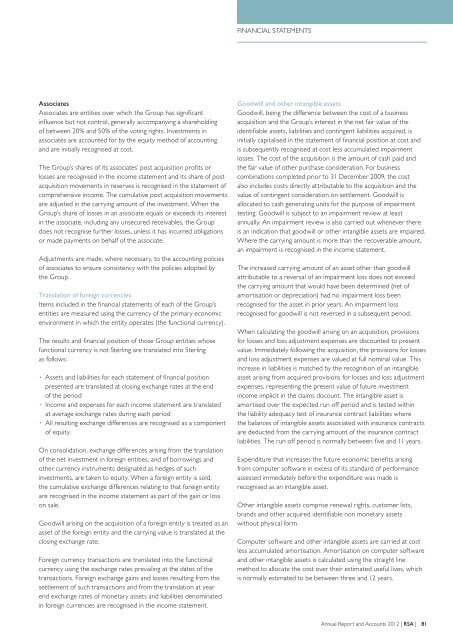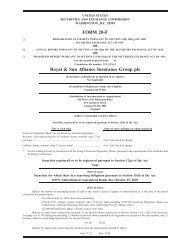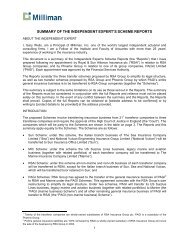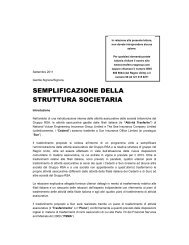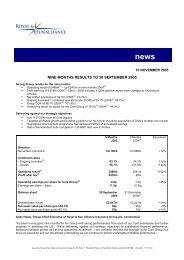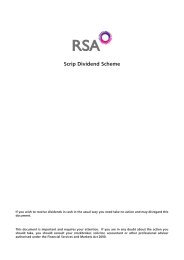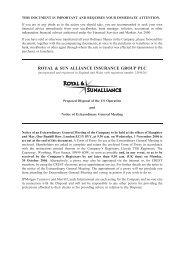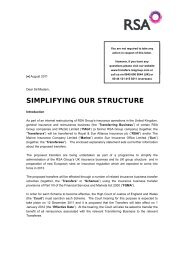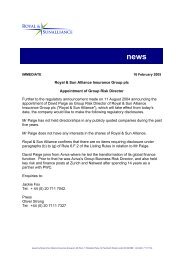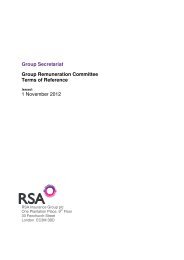ANNUAL REPORT AND ACCOUNTS 2012 - RSA, Annual Report ...
ANNUAL REPORT AND ACCOUNTS 2012 - RSA, Annual Report ...
ANNUAL REPORT AND ACCOUNTS 2012 - RSA, Annual Report ...
You also want an ePaper? Increase the reach of your titles
YUMPU automatically turns print PDFs into web optimized ePapers that Google loves.
FINANCIAL STATEMENTS<br />
Associates<br />
Associates are entities over which the Group has significant<br />
influence but not control, generally accompanying a shareholding<br />
of between 20% and 50% of the voting rights. Investments in<br />
associates are accounted for by the equity method of accounting<br />
and are initially recognised at cost.<br />
The Group’s shares of its associates’ post acquisition profits or<br />
losses are recognised in the income statement and its share of post<br />
acquisition movements in reserves is recognised in the statement of<br />
comprehensive income. The cumulative post acquisition movements<br />
are adjusted in the carrying amount of the investment. When the<br />
Group’s share of losses in an associate equals or exceeds its interest<br />
in the associate, including any unsecured receivables, the Group<br />
does not recognise further losses, unless it has incurred obligations<br />
or made payments on behalf of the associate.<br />
Adjustments are made, where necessary, to the accounting policies<br />
of associates to ensure consistency with the policies adopted by<br />
the Group.<br />
Translation of foreign currencies<br />
Items included in the financial statements of each of the Group’s<br />
entities are measured using the currency of the primary economic<br />
environment in which the entity operates (the functional currency).<br />
The results and financial position of those Group entities whose<br />
functional currency is not Sterling are translated into Sterling<br />
as follows:<br />
• Assets and liabilities for each statement of financial position<br />
presented are translated at closing exchange rates at the end<br />
of the period<br />
• Income and expenses for each income statement are translated<br />
at average exchange rates during each period<br />
• All resulting exchange differences are recognised as a component<br />
of equity.<br />
On consolidation, exchange differences arising from the translation<br />
of the net investment in foreign entities, and of borrowings and<br />
other currency instruments designated as hedges of such<br />
investments, are taken to equity. When a foreign entity is sold,<br />
the cumulative exchange differences relating to that foreign entity<br />
are recognised in the income statement as part of the gain or loss<br />
on sale.<br />
Goodwill arising on the acquisition of a foreign entity is treated as an<br />
asset of the foreign entity and the carrying value is translated at the<br />
closing exchange rate.<br />
Foreign currency transactions are translated into the functional<br />
currency using the exchange rates prevailing at the dates of the<br />
transactions. Foreign exchange gains and losses resulting from the<br />
settlement of such transactions and from the translation at year<br />
end exchange rates of monetary assets and liabilities denominated<br />
in foreign currencies are recognised in the income statement.<br />
Goodwill and other intangible assets<br />
Goodwill, being the difference between the cost of a business<br />
acquisition and the Group’s interest in the net fair value of the<br />
identifiable assets, liabilities and contingent liabilities acquired, is<br />
initially capitalised in the statement of financial position at cost and<br />
is subsequently recognised at cost less accumulated impairment<br />
losses. The cost of the acquisition is the amount of cash paid and<br />
the fair value of other purchase consideration. For business<br />
combinations completed prior to 31 December 2009, the cost<br />
also includes costs directly attributable to the acquisition and the<br />
value of contingent consideration on settlement. Goodwill is<br />
allocated to cash generating units for the purpose of impairment<br />
testing. Goodwill is subject to an impairment review at least<br />
annually. An impairment review is also carried out whenever there<br />
is an indication that goodwill or other intangible assets are impaired.<br />
Where the carrying amount is more than the recoverable amount,<br />
an impairment is recognised in the income statement.<br />
The increased carrying amount of an asset other than goodwill<br />
attributable to a reversal of an impairment loss does not exceed<br />
the carrying amount that would have been determined (net of<br />
amortisation or depreciation) had no impairment loss been<br />
recognised for the asset in prior years. An impairment loss<br />
recognised for goodwill is not reversed in a subsequent period.<br />
When calculating the goodwill arising on an acquisition, provisions<br />
for losses and loss adjustment expenses are discounted to present<br />
value. Immediately following the acquisition, the provisions for losses<br />
and loss adjustment expenses are valued at full nominal value. This<br />
increase in liabilities is matched by the recognition of an intangible<br />
asset arising from acquired provisions for losses and loss adjustment<br />
expenses, representing the present value of future investment<br />
income implicit in the claims discount. The intangible asset is<br />
amortised over the expected run off period and is tested within<br />
the liability adequacy test of insurance contract liabilities where<br />
the balances of intangible assets associated with insurance contracts<br />
are deducted from the carrying amount of the insurance contract<br />
liabilities. The run off period is normally between five and 11 years.<br />
Expenditure that increases the future economic benefits arising<br />
from computer software in excess of its standard of performance<br />
assessed immediately before the expenditure was made is<br />
recognised as an intangible asset.<br />
Other intangible assets comprise renewal rights, customer lists,<br />
brands and other acquired identifiable non monetary assets<br />
without physical form.<br />
Computer software and other intangible assets are carried at cost<br />
less accumulated amortisation. Amortisation on computer software<br />
and other intangible assets is calculated using the straight line<br />
method to allocate the cost over their estimated useful lives, which<br />
is normally estimated to be between three and 12 years.<br />
<strong>Annual</strong> <strong>Report</strong> and Accounts <strong>2012</strong> | <strong>RSA</strong> | 81


